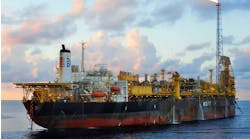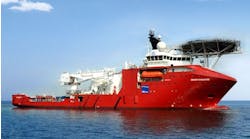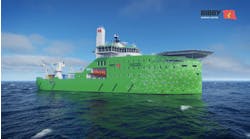PNG, East Java applications prove vessel array
The upgraded GeoMariner 1.A geophysical contractor has fulfilled a rolling program in the Far East, using the same 2D vessel for high resolution deepwater as well as very shallow water seismic surveys. According to GeoMarine of Bude, UK, work in the East Java Sea has proven that shallow water seismic acquisition using traditional 2D towed streamers can be a cost-effective alternative to ocean bottom cable techniques.
The vessel employed was theGeoMariner 1, originally constructed in 1978 to perform exploration on Exxon's behalf in the McKenzie River in the Canadian Arctic. The vessel had been built with a "flat-bottom" hull and aluminum superstructure to allow it to work in shallow waters. Following several successful summer seasons, it was released by Exxon in 1987, then laid-up until 1996, when it was sold for duty as an anchor handler on the Prince Edward Island bridge project. However, GeoMarine then stepped in early in 1997 to purchase the vessel with a view to refurbishment for seismic duty. Subsequent renovations/equipment overhauls that year included:
- Maintenance and modifications in drydock to bring the vessel in line with US Coastguard regulations (performed in Pictou, Nova Scotia)
- Above water modifications, compressor/ instrument room and streamer winch installation, including air-conditioning units (conducted in Morgan City, Louisiana)
- Seismic outfitting, including installation and commissioning of a ProMAX QC system, streamer recording system, air-guns and navigation system (performed in Corpus Christi, Texas).
All three surveys were conducted between February and May 1998. The Pai/Morigi-Rama survey in the western part of licence PPL 188 included lines which were programmed to extend into PPL 179. For operational convenience, the two sets of lines were acquired in sequence. In addition, parts of the Matabudi survey in licence PPL 179 were undertaken during this period in order to optimize acquisition of data in shallow water areas during the prevailing tidal cycles. The third survey, within licence APPL 200, was completed early in May, following which the vessel moved to Port Moresby for demobilization. In total, 4,065 line km of 2D seismic was acquired.
2.8-meter depths
Due to the shallowness of the water to be surveyed - in places, the program lines were run into depths as little as 2.8 meters - the operator assumed that ocean bottom cable (OBC) techniques would have to be applied. With OBC, a large network of recording arrays are laid on the seabed. A gunboat then traverses the network while another stationary vessel records the signals returned to the recording array.In GeoMarine's view, this had a number of disadvantages relative to towed array deployment, namely: time consumption, both labor and vessel-intensive, poor resolution of the top 2-3 seconds of the seismic record, and the technology is still in development.
GeoMarine persuaded Oil Search instead thatGeoMariner 1 and its towed array would be far more cost-effective, and could complete the surveys in a shorter time-scale. Following conclusion of this program, the vessel remained in the area under contract to Arco (Papua New Guinea). Its initial work for Arco consisted of about 1,473 km of full-fold data off the Fly River Estuary within exploration permit licence area PPL 182. Work was completed during May-June 1998.
East Java
Completing its commitments in the Gulf of Papua, the vessel then mobilized to East Java under contract to CGG's Indonesian subidiary, PT Alico, to manage a survey for Santos (Sampang). The location was south of Madura Island. This was to be a conventional 2D program, again using the vessel's Syntrak 480-24 MTU digital telemetry system, but with a 1,500-meter streamer for data acquisition. A 3,000-meter streamer had been proposed, but due to numerous obstructions in the survey area, streamer length had to be reduced.Most of the lines required scouting in order to map obstructions and depth restrictions. Shooting and scouting operations were restricted to daylight hours because of the number of fixed obstructions and small fishing vessels without navigation lights. Some programmed lines were subsequently moved to permit safe acquisition. In total, 680 km were acquired during August 1998.
Following a planned maintenance period in Surabaya, Indonesia, during which a full ABS Special Survey was undertaken, the vessel then sailed to Vung Tau, Vietnam under contract to PetroVietnam PSC Supervising Company. Work started in late October and was completed end-January. The program involved acquisition of around 3,000 2D line km in exploration permit licence areas 133 and 134, located 200 km offshore Vietnam. According to GeoMarine, the survey location provided proof of the vessel's versatility in being able to switch from shallow water acquisition to more traditional deepwater surveys. The vessel averaged around 78 km/day on this job.
Currently, GeoMarine is negotiating further contracts for traditional 2D and shallow water surveys off Vietnam, Indonesia and Australia's west coast, and hopes ultimately to purchase a second shallow draft vessel, once exploration picks up again. When that happens, theGeoMariner 1 will be upgraded to full multi-streamer 3D capability.
Copyright 1999 Oil & Gas Journal. All Rights Reserved.




